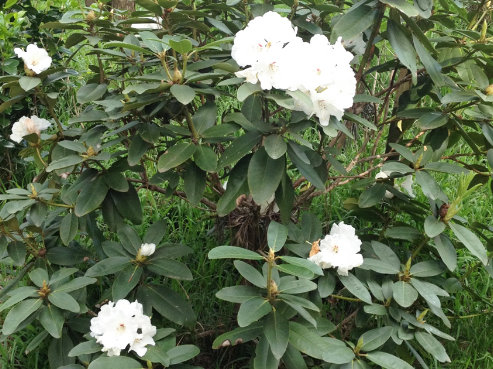Our first 10 years on Mount Tamborine

The cottage design indicates a Ski Lodge origin
What has gardening here taught us during Our First 10 Years
- Old, red, low pH rainforest soils are alluvial and do not hold moisture well. Special efforts are required for new plantings to add organic matter plus “water crystals” as a moisture pool around roots. As well, old cow pasture will have been mined of mineral content by grazing and, being subject to heavy rain, has micromineral deficiencies of Copper and Zinc. Avoiding plants that require a neutral or alkaline pH is essential. These comments do not apply to the grey loams of the eucalypt forests in the escarpments of Tamborine Mountain, whose soil composition and structure is different from the red volcanic loams found on the Plateau.
- The elevated position 550 metres above sea level increases the exposure of plants to thermal and radiant stress. Planting is best delayed until there is consistent cloud cover and plenty of soil moisture during the wet season. New plants require shade shelter for at least 3 weeks before they can be subject to full sun, and constantly watered. The gardener (as well) is also being irradiated with higher levels of ultraviolet radiation, and sun protection is essential for skin and eyes. There is no layer of pollution or humidity haze at this height to disperse radiant energy.
- The most successful plants are those which grow naturally in the rainforest. It seems almost too simple to say that, but trying to grow exotic species, especially cool temperate species like rhododendrons is a big challenge. There is still plenty of scope with garden design to incorporate the more resilient natives.
- Frost sensitive plants are risky choices and need a microenvironment capable of sheltering them from temperatures which may reach minus 5 degrees Celsius on occasions, depending on the season.
- Expect to get huge downpours in mid- to late summer, flooding creeks and damaging irrigation equipment, and possibly bringing down large trees. Yet the Spring and early summer can in some years be very dry and hot, killing plants with heat and water stress. Examples were 2012, 2013 and 2019. Everyone who lives at Mt Tamborine is dependent on tank water, and many would be buying in water for the household during these seasons. Water obtained from the weir is mainly seepage through soils upstream in the catchment. Hence, is acidic from the tannins derived from plant roots. The water is low in sodium but acidic.
- Kikuyu may be an excellent grass for withstanding heavy rainfall; yet its invasiveness and vigour can be a massive challenge in the wet season, requiring mowing every 2 to 3 weeks. Miss an opportunity to keep it under control, and you will have knee high grass not capable of being mowed with a ride-on mower. Call in the slasher! Its invasiveness means that garden beds are continually underrun by this grass. Even double weed mat fails to keep it out. Garden beds are best situated where none of this grass is growing.
- It seems like an unusual thing to mention, but trash dropped from the trees means a lot of stick picking before you can mow, especially under the big eucalypts. Some wood is useful for winter heating but most of it ends up at the green waste pile at the dump before it gets mulched. It is surprising just how much trash a eucalypt can generate. The only wood burning at The Overflow occurs with fallen boughs in the old wood stove for winter heating and cooking.

White Rhododendron Mt Everest
Our most successful plants
Natives: Without rival, the tree waratah is perfectly adapted to this property and gets a special mention, as I have never had a failure – in drought, heat, frost, flood it hangs on, and eventually reveals its beautiful red crowns
All natural inhabitants of the rainforest – hoop pine, bunya, eucalypts, black bean, lilly pilly, acacias, banksias, blue quandongs, tallow wood, messmates, silky oaks, red cedar all do very well. Flame trees can be good if situated in a location providing constant moisture. Tree ferns must have constant moisture but do not like to be submerged. They can die in prolonged droughts. Staghorns and elkhorns thrive if given good shade and exposure on the south east side of their home tree – the direction of most of the rain bearing winds.
Native vines like Aristolochia, Pandorea jasminoides, gingers and Brunsfeldias do well if they have a little shade for their base and roots and plenty of moisture.
